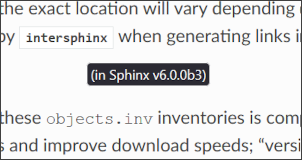Sphinx objects.inv v2 Syntax
After decompression, “version 2” Sphinx objects.inv files follow a syntax that, to the best of this author’s ability to determine, is not included in the Sphinx documentation. The below syntax is believed to be accurate as of Nov 2022 (Sphinx v6.0.0b2). It is based on inspection of objects.inv files “in the wild” and of the Sphinx inventory object parsing regex.
Based upon a quick git diff of the Sphinx repository, it is thought to be valid for all
Sphinx versions >=1.0b1 that make use of this “version 2” objects.inv format.
NOTE that previous versions of the syntax presented here have been shown to be inaccurate:
The descriptions below have been updated to reflect this and to provide more detailed information on the constraints governing each field of an objects.inv data line.
The first line must be exactly:
# Sphinx inventory version 2
The second and third lines must obey the template:
# Project: <project name>
# Version: <full version number>
The version number should not include a leading “v”.
The above project name and version are used to populate mouseovers for
the intersphinx cross-references:
The fourth line must contain
the string zlib somewhere within it, but for consistency it should be exactly:
# The remainder of this file is compressed using zlib.
All remaining lines of the file are the objects data, each laid out in the following syntax:
{name} {domain}:{role} {priority} {uri} {dispname}
{name}
The object name used when cross-referencing the object (falls between the backticks).
Constraints
MUST have nonzero length
MUST NOT start with
#SHOULD have no leading or trailing whitespace
MAY contain internal whitespace
{domain}The Sphinx domain used when cross-referencing the object (falls between the first and second colons; omitted if using the default domain).
Constraints
MUST have nonzero length
MUST match a built-in or installable Sphinx domain
MUST NOT contain whitespace or a colon
RECOMMENDED to contain only ASCII word characters (
a-z,A-Z,0-9, and_)
{role}The Sphinx role used when cross-referencing the object (falls between the second and third/last colons; or, between the first and second/last colons if using the default domain).
Note that the role MAY contain a colon, as occurs with the
:rst:directive:option:directive in the Sphinx docs.Constraints
MUST have nonzero length
MUST match a role defined in the domain referenced by
{domain}MUST NOT contain whitespace
RECOMMENDED to consist of only ASCII word characters (
a-z,A-Z,0-9, and_)
{priority}Flag for placement in search results. Most will be
1(standard priority) or-1(omit from results) for documentation built by Sphinx; values of0(higher priority) or2(lower priority) may also occur.To note, as of Jan 2022 this value is not used by
intersphinx; it is only used internally within the search function of the static webpages built by Sphinx (here and here). Thus, custom inventories likely MAY use this field for arbitrary content, if desired, as long as the integer constraint is observed. Such use would run the risk of a future change to Sphinx/intersphinx breaking compatibility with objects.inv files having non-standard{priority}values.Constraints
MUST have nonzero length
MUST be a positive or negative integer, or zero, without a decimal point
MUST NOT contain whitespace (implicit in the integer constraint)
{uri}Relative URI for the location to which cross-references will point. The base URI is taken from the relevant element of the
intersphinx_mappingconfiguration parameter inconf.py.Constraints
MAY have zero length, but typically has nonzero length
A zero-length
{uri}can occur for the root/index documentation page in certain instances; see sphinx-doc/sphinx#7096
MUST NOT contain whitespace
{dispname}Default cross-reference text to be displayed in compiled documentation.
Constraints
MUST have nonzero length
MAY contain internal whitespace (leading/trailing whitespace is ignored)
Unicode characters appear to be valid for all fields except
{uri} (where they are specifically forbidden)
and {priority}.
However, it is RECOMMENDED that they only be used in {dispname},
as their use in {name}, {domain} and {role} would complicate construction
of cross-references from other documentation source.
For illustration, the following is the entry for the
join() method of the str class in the
Python 3.9 objects.inv, broken out field-by-field:
str.join py:method 1 library/stdtypes.html#$ -
{name} = str.join
{domain} = py
{role} = method
{priority} = 1
{uri} = library/stdtypes.html#$
{dispname} = -
The above illustrates two shorthand notations that were introduced to shrink the size of the inventory file:
If
{uri}has an anchor (technically a “fragment identifier,” the portion following the#symbol) and the tail of the anchor is identical to{name}, that tail is replaced with$.
If
{dispname}is identical to{name}, it is stored as-.
Thus, a standard intersphinx reference to this method would take the form:
:py:meth:`str.join`
The leading :py here could be omitted if py is the default domain.
The cross-reference would show as str.join() and link to the relative URI:
library/stdtypes.html#str.join
Other intersphinx Syntax Examples
To show as only join():
:py:meth:`~str.join`
To suppress the hyperlink as in str.join():
:py:meth:`!str.join`
To change the cross-reference text and omit the trailing parentheses
as in This is join!:
:py:obj:`This is join! <str.join>`
